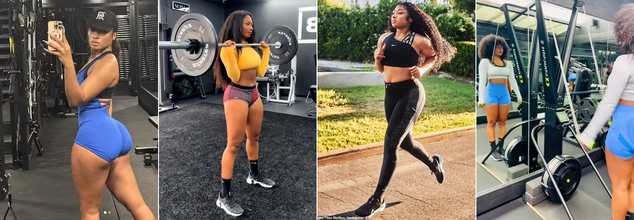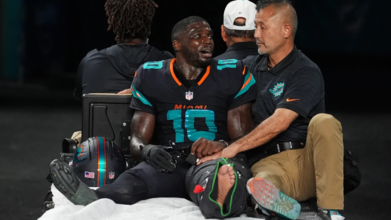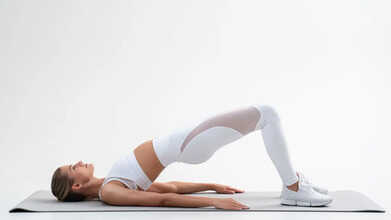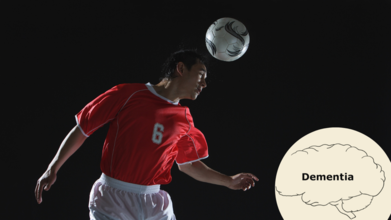- Health Conditions A-Z
- Health & Wellness
- Nutrition
- Fitness
- Health News
- Ayurveda
- Videos
- Medicine A-Z
- Parenting
- Web Stories
Megan Thee Stallion’s Gym Routine Is Brutal- This Is What She Eats Every Morning To Stay In Bombshell Shape

Image Credit: Instagram/@ Megan Thee Stallion
Megan Thee Stallion has made a name for herself with her powerful presence in the industry, but off stage, fitness has been a major factor in building Megan's mental and physical health. The three-time Grammy Award winner has spoken about how working out has assisted her in dealing with personal struggles, such as the traumatic 2020 shooting attack by fellow rapper Tory Lanez.
Megan has been open about her struggles after the shooting incident that critically injured her. As the court battle raged on for years, Megan was grappling with a psychological burden few could comprehend. The rapper talked about having hit rock bottom and going through severe depression in an interview with Women's Health. She said that she could barely get out of bed.
"I didn't want to get [out] under the covers," Megan said. "I just stayed in my room. I would not turn the light on. I had blackout curtains. I didn't want to see the sun. I knew I wasn't myself. It took me a while to admit I was depressed."
But therapy and fitness were her solace. "Working on myself made me get into working out because I had to direct my energy somewhere else," she stated. "I used working out to escape and to become happy."
Inside Megan Thee Stallion's Workout Regimen
Megan Thee Stallion's training regimen is as tough as her performances. She exercises four to five days a week, combining high-intensity cardio, strength training, and Pilates. Whether she is working out hard in the gym, at home, or even on the beach, her exercises are crafted to enhance endurance, give her body shape, and increase her mental toughness.
1. High-Intensity Cardio for Stamina
Cardio features prominently in Megan's training schedule, particularly during tour time. She devotes 40 minutes to doing cardio such as:
- The StairMaster
- The elliptical
- Treadmill sprints
She even went on to say on TikTok that sometimes she does a whopping 90 minutes of cardio a day, going back-to-back with performances.
2. Strength Training for a Sculpted Physique
Megan puts a high priority on strength training to develop muscle and keep her signature toned physique. Her strength training sessions both upper and lower body include the following exercises:
- Goblet squats to have strong legs
- Leg extensions and hip thrusts to activate glutes
- Donkey kicks, which she refers to as "stallion kicks"
- Renegade rows, lat pulldowns, and lat flies to develop upper-body strength
- Weighted sit-ups to retain defined abs
3. Pilates for Core Stability and Flexibility
Pilates is yet another integral part of Megan's workout. Pilates assists her in toning the core, maintaining good posture, and enhancing overall flexibility. Pilates is a low-impact exercise as well and serves to aid in prevention and recovery from injury, thereby being an ideal complement to her high-intensity workouts.
Megan Thee Stallion's Diet
In addition to her rigorous workout routine, Megan also maintains a diet that nourishes her body with wholesome foods. She emphasizes whole foods, lean protein, and water to keep her energy up.
Megan consumes roughly a gallon of water every day to stay hydrated and have radiant skin. She has also replaced sugary beverages and juice with water and green tea for a healthier option.
Megan's diet is nicely balanced with emphasis on lean proteins, fiber, and healthy fats:
Breakfast: A green juice (prepared with spinach, kale, ginger, turmeric, apples, and collagen powder) or a protein smoothie with strawberries, bananas, almond milk, and protein powder.
Lunch: Pan-seared salmon with fiber-rich vegetables.
Dinner: Fish such as cod or sea bass, with sides of sweet potatoes, kale, tomatoes, or brown rice.
She also reduced her red meat, bread, and heavy sauce intake while choosing tequila over cognac in an effort to lower her sugar levels.
How Megan Sets the Tone for the Day with her Morning Routine
One of the key elements of Megan's wellness and fitness strategy is her routine morning regimen. She begins each day with activities that get her mentally and physically centered, including:
- Journaling
- Meditation
- Prayer
- A hydrating face mask
- Spend time with her dogs
- Listen to music
This period of self-care gives her time to prepare herself mentally for the day that lies ahead before she enters her workout.
"Waking up from bed to work out in the morning is tough," Megan conceded. "I need to psyche myself up. I'm like, 'I can stay here an hour more, or I can wake up and go work out and be a bad b----.' If I'm gonna be a stallion and not a pony, I gotta wake up and get to work."
Why Megan Thee Stallion's Routine Succeeds
Megan Thee Stallion's workout routine is not just about being good-looking—it's about being strong and empowered. Her mix of routine workouts, conscientious eating, and mental well-being practices proves that health equals balance. By making fitness a way to heal emotionally, she has changed not only her physique, but her attitude too.
Her commitment to putting herself first is a motivating reminder that taking charge of one's health—physical and mental—is the path to resilience, confidence, and inner strength. No matter what your fitness goals are, whether it's beginning a new regimen or simply finding the motivation to get active, Megan's method reminds us that getting out and being there for yourself is always well worth it.
Tyreek Hill Injury: Left Knee Dislocated; Know More About The Common Leg Injuries In Football

Credits: AP
Miami Dolphin's Tyreek Hill's season came to a sudden end on Monday night, when his knee became badly twisted shortly after he made a catch near the sideline. The coach Mike McDaniel confirmed that Hill was diagnosed with a dislocated knee and had to be in hospital overnight.
An air cast was also placed over his leg, which was taken off the field on cart. He was then taken to a nearby hospital, and kept for "imaging, evaluation, and observation".
McDaniel said, "He immediately had wide eyes and was talking, 'I'm good, just make sure the guys get this win.' He was focused on the team."
As of now, Hill will be undergoing an MRI exam and a CT scan. His agent Drew Rosenhaus told WSVN that he is being checked for any torn ligaments, cartilage, broken bones or nerve damage.
Associated Press has reported that Hill ha been taken off field for left knee dislocation.
What Happens In A Knee Dislocation?
As per the National Institute of Health, US, a knee dislocation is a potentially devastating injury and is often a surgical emergency. Knee dislocations comprise ligamentous, bony, and neurovascular injuries that, when unrecognized, significantly increase the risk of amputation of the affected limb. Even dislocations that spontaneously reduce before evaluation by a healthcare professional carry the risk of significant neurovascular injury.
Delayed diagnosis and management of knee dislocations increases the risk of long-term arthrofibrosis and joint instability. While most dislocated knees never fully return to their pre-injury state, timely and accurate diagnosis paired with prompt intervention can significantly improve outcomes for patients with this potentially complex orthopedic injury.
Common Leg Injuries In Football
As per the Southern Pain and Neurological Clinic, football is one of the most dangerous contact sports in the United States, this is also a reason why players wear layers of protective clothing and equipment.
According to the National Library of Medicine, the most common injury types in football include strains at 40%, contusions at 25%, dislocations at 15%, fractures at 10%, and concussions at 5%.
Read: 21-year-old Billy Vigar Of Chichester City Dies Of Sustaining Brain Injury
Common Injuries Include:
Muscle Strains
This happens when a muscle or tendon is overstretched, mainly due to acceleration or deceleration. This injury is also known as pulled muscles and typically affects the lower back, hamstrings, or ankles.
Knee Ligament Injury
Ligaments connect bones in the body, and ligaments that connect the lower leg to the thigh bone are most susceptible to injuries in football.
There are four knee ligaments injuries that can happen:
- ACL or the Anterior cruciate ligament at the center of the knee
- PCL or the Posterior cruciate ligament at the center of the knee
- MCL or the Medial collateral ligament on the inside of the knee
- LCL or the Lateral collateral ligament on the outside of the knee
Among these, the most common knee ligament injury in football is the rapture of the ACL. This is because it is the ligament that controls the rotation of the shinbone and forward movement.
Achilles Tendonitis
This happens when the tendon linking the calf muscles to the heel becomes irritated or injured. This often results from intense or repetitive strain. The condition can cause sharp pain and, in severe cases, make it difficult or even impossible to walk, jump, or move the toes.
Hamstring Strains
This happens when a player over stretches while running, jumping, or in action. This happens with a sharp pain at the back of the thigh and in severe cases, a player may have a torn hamstring.
5 Pelvic Floor Exercises That Can Transform Your Sexual Wellness

Credits: Canva
Your pelvic floor muscles do much more for your sexual health than most people realise. These deep muscles support the bladder, uterus, and bowel, but they also play a big part in pleasure, performance, and confidence during intimacy.
Whether you’re healing after childbirth, managing incontinence, or simply aiming to feel more connected with your body, training your pelvic floor is a natural way to improve sexual wellness.
What Is Pelvic Floor Exercise?
Pelvic floor exercises, often called Kegels, focus on strengthening the group of muscles that create a supportive sling for the bladder, bowel, and, in women, the uterus. They are done by contracting these muscles, as if stopping the passage of urine or gas, holding the squeeze, and then releasing. Regular practice can improve bladder and bowel control, enhance sexual health, and aid recovery following childbirth in women or prostate surgery in men.ALSO READ: Is It Safe To Have Sex With Heart Disease? Expert Tells 5 Things You Should Keep In Mind
Benefits of Pelvic Floor Exercise For Better Sexual Health
Pelvic floor exercises can make a real difference in your sexual life. As per Mayo Clinic, by strengthening the muscles that support the bladder, uterus, and bowel, these exercises improve blood flow and muscle control in the pelvic area. This not only enhances arousal and sensitivity but can also lead to stronger orgasms and better stamina during intimacy. For many people, a stronger pelvic floor helps reduce discomfort, boost confidence, and create a greater sense of connection with their body and partner.ALSO READ: Can A UTI Cause You Your Limbs? Explains Doctor
5 Pelvic Floor Exercises to Boost Sexual Health
1. Kegel Exercises
How to do it:- Squeeze the muscles you use to stop urinating.
- Hold for 5 seconds, then relax for 5 seconds.
- Repeat 10–15 times, two to three times daily.
2. Bridge Pose
How to do it:- Lie on your back with your knees bent and feet flat.
- Lift your hips upward while tightening your glutes and pelvic muscles.
- Hold briefly, then lower down.
3. Deep SquatsHow to do it:
- Stand with your feet hip-width apart.
- Lower into a deep squat, keeping your chest lifted.
- Engage your pelvic muscles as you come back up.
4. Bird-Dog
How to do it:- Begin on your hands and knees.
- Extend your right arm and left leg at the same time.
- Hold, then switch sides.
5. Pelvic Tilts
How to do it:- Lie on your back with your knees bent.
- Flatten your lower back into the floor by tilting your pelvis upward.
- Hold for a few seconds, then relax.
Love Playing Football? Studies Show That Footballers Face A Higher Dementia Risk

Credits: Canva
Football, the world’s most popular sport, may come with an invisible cost: brain health. While players are celebrated for their stamina, skill, and longevity on the pitch, research shows that elite footballers are more likely to develop dementia and related neurodegenerative diseases later in life compared with the general population.
The main factor? Heading the ball.
The Swedish Study: What It Found
A major cohort study, published in The Lancet Public Health in 2023, followed 6,007 male footballers who had played in Sweden’s top division between 1924 and 2019. Their health outcomes were compared with 56,168 men from the general population.
- 8.9% of footballers were diagnosed with a neurodegenerative disease versus 6.2% of controls.
- Footballers had a 1.46 times higher risk of developing these conditions.
- Alzheimer’s disease and other dementias were significantly higher among players, with a 62% increased risk.
- No increased risk was found for motor neuron disease.
Surprisingly, footballers had a lower risk of Parkinson’s disease.
But the most striking finding was the difference between player positions. Outfield players, who head the ball regularly, showed a 50% higher risk compared with the general population, while goalkeepers, who rarely head the ball, showed no significant increase in risk.
This position-based difference strongly suggests that repetitive head impacts, even those not causing concussions, play a central role in long-term brain health risks.
Confirming Earlier Evidence
These Swedish results echo a 2019 Scottish study published in The New England Journal of Medicine, which found that former professional footballers were 3.5 times more likely to die of neurodegenerative disease compared with controls. That study also highlighted that defenders, who head the ball most often, were at the greatest risk.
Together, these studies strengthen the link between heading the ball and higher dementia risk, adding to growing international concern about football’s long-term safety.
Also Read: 21-year-old Billy Vigar Of Chichester City Dies Of Sustaining Brain Injury
Why Football Differs From Other Sports
Sports like boxing, rugby, American football, and ice hockey are already well-known for head injury risks. However, football is unique because concussions are relatively rare (<0.1 events per 1,000 player-hours), yet players repeatedly use their heads to control and redirect the ball.
This creates frequent “sub-concussive impacts”, blows to the brain too mild to cause immediate symptoms but capable of triggering long-term neurodegenerative changes. Chronic traumatic encephalopathy (CTE), a condition linked to repeated head trauma, has already been identified in athletes from other collision sports. Football’s heading tradition may be creating similar risks.
Changing the Game: Calls for Action
- Recognizing these risks, football associations have started to act.
- In the UK, heading is restricted in children’s training sessions.
- UEFA has issued guidelines limiting headers in youth football.
- In England, rules now cap the number of high-force headers in training for adult professionals.
Experts, however, stress that these measures may not be enough. Tara Spires-Jones, professor of neurodegeneration at the University of Edinburgh, noted that the stark difference between outfield players and goalkeepers reinforces the link between head impacts and dementia. She emphasized that while sports and physical activity overall reduce dementia risk, avoiding repetitive head injury is crucial for brain protection.
Has Modern Football Changed the Risk?
One question remains: do today’s footballers face the same level of risk as those who played in the mid-20th century?
The Swedish study noted that most players diagnosed with neurodegenerative disease had careers before the 1970s. Since then, major changes have reshaped the sport:
- Leather balls, which absorbed water and became heavier, have been replaced by lighter synthetic ones.
- Training methods, tactics, and playstyles have evolved, potentially reducing—or even increasing—head trauma exposure.
- The modern game involves far more matches and intense training, meaning players may head the ball more frequently over a lifetime.
- Researchers caution that the long-term risks for today’s players remain uncertain, and ongoing monitoring is essential.
© 2024 Bennett, Coleman & Company Limited

